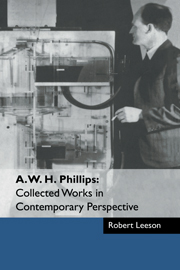Book contents
- Frontmatter
- Contents
- List of contributors
- Foreword by Arthur Brown
- Preface by Robert Leeson
- Part I Bill Phillips: Some Memories and Reflections
- Part II The Phillips Machine
- 8 The origins of the machine in a personal context
- 9 The Phillips Machine as a ‘progressive’ model
- 10 Mechanical models in economic dynamics
- 11 The history of the Phillips Machine
- 12 Early reactions to Mark I and II
- 13 A superb explanatory device
- 14 The Phillips Machine and the history of computing
- Part III Dynamic Stabilisation
- Part IV Econometrics
- References
- Index of names
- Index of subjects
12 - Early reactions to Mark I and II
Published online by Cambridge University Press: 04 May 2010
- Frontmatter
- Contents
- List of contributors
- Foreword by Arthur Brown
- Preface by Robert Leeson
- Part I Bill Phillips: Some Memories and Reflections
- Part II The Phillips Machine
- 8 The origins of the machine in a personal context
- 9 The Phillips Machine as a ‘progressive’ model
- 10 Mechanical models in economic dynamics
- 11 The history of the Phillips Machine
- 12 Early reactions to Mark I and II
- 13 A superb explanatory device
- 14 The Phillips Machine and the history of computing
- Part III Dynamic Stabilisation
- Part IV Econometrics
- References
- Index of names
- Index of subjects
Summary
Richard Sayers was considered to be the most precise and most compre- hensible lecturer at LSE. In the Spring of 1949 he received a letter that said in effect:
I have great difficulty in trying to understand your lectures. I know something about plumbing [a gross understatement], and have tried to sketch a hydraulic model similar to the one on page 117 of Boulding. I enclose a copy of my sketch. Could you please comment on it?
Sayers was meticulous in responding to any approach by a student. He asked me to see the author of the note. I met with Bill, discussed his model, suggested some changes in his flows, and arranged for him to meet with Ralph Turvey. By then, examinations were near and Bill had to spend the rest of the term working on his sociology.
At the end of term, two people, in particular, were enthusiastic regarding the design: Walter Newlyn and Bill's landlord (the Mr Langley, a former employee of the metropolitan Water Board with a well-equipped work shed in his garage, referred to in Bill's acknowledgement at the beginning of chapter 10). Walter Newlyn guaranteed an overdraft to allow Bill to purchase the components for his machine (Mark I). Mr and Mrs Langley offered him free room and board for the summer, one cinema visit with them and one packet of cigarettes per week (Bill must have had other resources to satisfy his nicotine needs).
- Type
- Chapter
- Information
- A. W. H. Phillips: Collected Works in Contemporary Perspective , pp. 115 - 117Publisher: Cambridge University PressPrint publication year: 2000
- 2
- Cited by

